Dynamics of Two Caldera-Forming Eruptions (Banda Besar and Naira) in the Marine Conservation Zone of Banda, Maluku, Indonesia
Abstract
1. Introduction
2. Banda Volcanic Complex
3. Analytical Methods
3.1. Fieldwork
3.2. Grain Size Distribution and Componentry
3.3. Isopach Map, Eruption Intensity, and Plume Height
3.4. Petrography
3.5. Bulk-Rock Chemical Composition
4. Results
4.1. Stratigraphy of Banda Besar
4.2. Stratigraphy of Naira
4.3. Stratigraphy of Banda Api
4.4. Depositional Mechanism
4.5. Summary of Components
4.5.1. Vertical Componentry Variation of Banda Besar Pumice
4.5.2. Vertical Componentry Variation of Naira Pumice
4.6. Deposit Distribution, Eruption Intensity, and Volume
4.7. Petrography
4.8. Bulk-Rock Composition
5. Discussion
5.1. Magmatic Origins of Banda Besar and Naira Pumice
5.2. Reconstruction of Banda Besar Eruption
5.3. Reconstruction of Naira Caldera-Forming Eruption
5.4. Future Hazards
6. Conclusions
Author Contributions
Funding
Data Availability Statement
Acknowledgments
Conflicts of Interest
References
- Self, S.; Rampino, M.R. The 1883 eruption of Krakatau. Nature 1981, 294, 699–704. [Google Scholar] [CrossRef]
- Mandeville, C.W.; Carey, S.; Sigurdsson, H. Magma mixing, fractional crystallization and volatile degassing during the 1883 eruption of Krakatau volcano, Indonesia. J. Volcanol. Geotherm. Res. 1996, 74, 243–274. [Google Scholar] [CrossRef]
- Williams, R.; Rowley, P.; Garthwaite, M.C. Reconstructing the Anak Krakatau flank collapse that caused the December 2018 Indonesian tsunami. Geology 2019, 47, 973–976. [Google Scholar] [CrossRef]
- Jezek, P.A.; Hutchison, C.S. Banda Arc of Eastern Indonesia: Petrology and Geochemistry of the Volcanic Rocks. Bull. Volcanol. 1978, 41, 586–608. [Google Scholar] [CrossRef]
- Van Bergen, M.J.; Erfan, R.D.; Sriwana, T.; Suharyono, K.; Poorter, R.P.E.; Varekamp, J.C.; Vroon, P.Z.; Wirakusumah, A.D. Spatial geochemical variations of arc volcanism around the Banda Sea. Neth. J. Sea Res. 1989, 24, 313–322. [Google Scholar] [CrossRef]
- Center for Volcanology and Geological Hazard Mitigation (CVGHM). Data Dasar Gunung Api Indonesia. 2022. Available online: https://vsi.esdm.go.id/index.php/gunungapi/data-dasar-gunungapi (accessed on 11 September 2022).
- Chesner, C.A.; Rose, W.I. Stratigraphy of the Toba Tuffs and the evolution of the Toba Caldera Complex, Sumatra, Indonesia. Bull. Volcanol. 1991, 53, 343–356. [Google Scholar] [CrossRef]
- Kaneko, K.; Kamata, H.; Koyaguchi, T.; Yoshikawa, M.; Furukawa, K. Repeated large-scale eruptions from a single compositionally stratified magma chamber: An example from Aso volcano, Southwest Japan. J. Volcanol. Geotherm. Res. 2007, 167, 160–180. [Google Scholar] [CrossRef]
- Swallow, E.J.; Wilson, C.J.N.; Charlier, B.L.A.; Gamble, J.A. The Huckleberry Ridge Tuff, Yellowstone: Evacuation of multiple magmatic systems in a complex episodic eruption. J. Petrol. 2019, 60, 1371–1426. [Google Scholar] [CrossRef]
- Whitford, D.J.; Jezek, P.A. Origin of Late-Cenozoic lavas from the Banda Arc, Indonesia: Trace element and Sr isotope evidence. Cont. Min. Petrol. 1979, 68, 141–150. [Google Scholar] [CrossRef]
- Spakman, W.; Hall, R. Surface deformation and slab-mantle interaction during Banda arc subduction rollback. Nat. Geosci. 2010, 3, 562–566. [Google Scholar] [CrossRef]
- Wahyudin, D.; Kartadinata, M.N.; Taufiqurrahman, R.; Abdurachman, E.K.; Prambada, O.; Lusy, A.S.; Purwoto, E.; Ridwan, I. Peta Geologi Gunungapi Banda Api, Provinsi Maluku. Departemen Energi daan Sumber Daya Mineral, Pusat Vulkanologi dan Mitigasi Bencana Geologi. 2009. Available online: https://vsi.esdm.go.id/gallery/picture.php?/85 (accessed on 5 November 2022).
- Kuna, V. Subduction Factory Interaction of Subduction-Related Magma with the Overlying Lithospheric Wedge. Bachelor’s Thesis, Univerzita Karlova, Přírodovědecká fakulta, Nové Město, Czechia, 2011. Available online: http://hdl.handle.net/20.500.11956/51097 (accessed on 5 November 2022).
- Asya’ri, M.F.; Sisriany, S.; Saputra, S.D.; Habi, M.S.; Hakim, R.A.; Pribadi, M.; Khrisrachmansyah, R. The archipelascape hazard mitigation system through sasi adat of Banda Api volcano, Moluccas, Indonesia. In Proceedings of the IFLA Asia Pacific Congress 2015, Lombok, Indonesia, 7–9 September 2015; pp. 161–169. [Google Scholar]
- Carey, S.; Sparks, R.S.J. Quantitative models of the fallout and dispersal of tephra from volcanic eruption columns. Bull. Volcanol. 1986, 48, 105–125. [Google Scholar] [CrossRef]
- Pradana, M.F.; Ramadhan, G.R.E.; Noche, B. Transport Cost Optimization of Offshore Wind Turbine Installation on the Indonesia Sea. Logist. J. 2021, 2021. [Google Scholar] [CrossRef]
- Meteorological, Climatological, and Geophysical Agency (BMKG). Ocean Forecast System. 2022. Available online: https://peta-maritim.bmkg.go.id/ofs (accessed on 5 November 2022).
- Sigurdsson, H.; Carey, S. Plinian and co-ignimbrite tephra fall from the 1815 eruption of Tambora volcano. Bull. Volcanol. 1989, 51, 243–270. [Google Scholar] [CrossRef]
- Gertisser, R.; Charbonnier, S.J.; Keller, J.; Quidelleur, X. The geological evolution of Merapi volcano, Central Java, Indonesia. Bull. Volcanol. 2012, 74, 1213–1233. [Google Scholar] [CrossRef]
- Vidal, C.M.; Komorowski, J.C.; Métrich, N.; Pratomo, I.; Kartadinata, N.; Prambada, O.; Michel, A.; Cararzzo, G.; Lavigne, F.; Rodysill, J.; et al. Dynamics of the major Plinian eruption of Samalas in 1257 A.D. (Lombok, Indonesia). Bull. Volcanol. 2015, 77, 73. [Google Scholar] [CrossRef]
- Prambada, O.; Arakawa, Y.; Ikehata, K.; Furukawa, R.; Takada, A.; Wibowo, H.E.; Nakagawa, M.; Kartadinata, M.N. Eruptive history of Sundoro volcao, Central Java, Indonesia since 34 ka. Bull. Volcanol. 2012, 78, 81. [Google Scholar] [CrossRef]
- Harpel, C.J.; Kushendratno; Stimac, J.; de Harpel, C.F.A.R.; Primulyana, S. The Orange Tuff: A Late Pleistocene tephra-fall deposit emplaced by a VEI 5 silicic Plinian eruption in West Java, Indonesia. Bull. Volcanol. 2019, 81, 33. [Google Scholar] [CrossRef]
- Mitsuoka, T.; Atsushi, T.; Harijoko, A.; Wibowo, H.E. Eruption Types and Conduit Dynamics of Kukusan and Genteng Volcanoes of the Ijen Volcanic Complex, Indonesia. Kyushu Univ. Int. Rep. Ser. D Earth Planet. Sci. 2021, 35, 1–17. [Google Scholar] [CrossRef]
- Faral, A.; Lavigne, F.; Mutaqin, B.W.; Mokadem, F.; Achmad, R.; Ningrum, R.W.; Lahitte, P.; Hadmoko, D.S.; Mei, E.T.W. A 22,000-year tephrostratigraphy record of unidentified volcanic eruptions from Ternate and Tidore islands (North Maluku, Indonesia). J. Volcanol. Geotherm. Res. 2022, 423, 107474. [Google Scholar] [CrossRef]
- Tajima, Y.; Tamura, K.; Yamakoshi, T.; Tsune, A.; Tsurumoto, S. Ellipse-approximated Isopach Maps for Estimating Asfall Volume at Sakurajima Volcano. Bull. Volcanol. Soc. Jap. 2013, 58, 291–306. [Google Scholar] [CrossRef]
- Walker, G.P.L. Explosive volcanic eruptions—A new classification scheme. Geol. Rundsch. 1973, 62, 431–446. [Google Scholar] [CrossRef]
- Engwell, S.L.; Sparks, R.S.J.; Aspinall, W.P. Quantifying uncertainties in the measurement of tephra fall thickness. J. Appl. Volcanol. 2013, 2, 5. [Google Scholar] [CrossRef]
- Engwell, S.L.; Aspinall, W.P.; Sparks, R.S.J. An objective method for the production of isopach maps and implications for the estimation of tephra deposit volumes and their uncertainties. Bull. Volcanol. 2015, 77, 61. [Google Scholar] [CrossRef]
- Suhendro, I.; Toramaru, A.; Miyamoto, T.; Miyabuchi, Y.; Yamamoto, T. Magma chamber stratification of the 1815 Tambora caldera-forming eruption. Bull. Volcanol. 2021, 83, 63. [Google Scholar] [CrossRef]
- Legros, F. Minimum volume of a tephra fallout deposit estimated from a single isopach. J. Volcanol. Geotherm. Res. 2000, 96, 25–32. [Google Scholar] [CrossRef]
- Tani, K.; Fiske, R.S.; Tamura, Y.; Kido, Y.; Naka, J.; Shukuno, H.; Takeuchi, R. Sumisu volcano, Izuz-Bonin arc, Japan: Site of a silicic caldera-forming eruption from a small open-ocean island. Bull. Volcanol. 2008, 70, 547–562. [Google Scholar] [CrossRef]
- Kandlbauer, J.; Sparks, R.S.J. New estimates of the 1815 Tambora eruption volume. J. Volcanol. Geotherm. Res. 2014, 286, 93–100. [Google Scholar] [CrossRef]
- Wilson, M. Igneous Petrogenesis, a Global Tectonic Approach; Springer: Dordrecht, The Netherlands, 1989; 466p. [Google Scholar] [CrossRef]
- Dall’agnol, R.; Scaillet, B.; Pichavant, M. An Experimental Study of a Lower Proterozoic A-type Granite from the Eastern Amazonian Craton, Brazil. J. Petrol. 1999, 40, 1673–1698. [Google Scholar] [CrossRef]
- McBirney, A.R. Igneous Petrology, 3rd ed.; Jones & Bartlett Learning: Burlington, MA, USA, 2007; 550p. [Google Scholar]
- Takeuchi, S. Preeruptive magma viscosity: An important measure of magma eruptibility. J. Geophys. Res. 2011, 116. [Google Scholar] [CrossRef]
- Ginibre, C.; Wörner, G.; Kronz, A. Structure and Dynamics of the Laacher See Magma Chamber (Eifel, Germany) from Major and Trace Element Zoning in Sanidine: A Cathodoluminescence and Electron Microprobe Study. J. Petrol. 2004, 45, 2197–2223. [Google Scholar] [CrossRef]
- Wilson, L.; Sparks, R.S.J.; Walker, G.P.L. Explosive volcanic eruptions—IV. The control of magma properties and conduit geometry on eruption column behavior. Geophys. J. Int. 1980, 63, 117–148. [Google Scholar] [CrossRef]
- Maeno, F.; Taniguchi, H. Spatiotemporal evolution of a marine caldera-forming eruption, generating a low-aspect-ratio pyroclastic flow, 7.3 ka, Kikai caldera, Japan: Implication from near-vent eruptive deposits. J. Volcanol. Geotherm. Res. 2007, 167, 212–238. [Google Scholar] [CrossRef]
- Madden-Nadeau, A.L.; Cassidy, M.; Pyle, D.M.; Mather, T.A.; Watt, S.F.L.; Engwell, S.L.; Abdurrachman, M.; Nurshal, M.E.M.; Tappin, D.R. The magmatic and eruptive evolution of the 1883 caldera-forming eruption of Krakatau: Integrating field- to crystal-scale observations. J. Volcanol. Geotherm. Res. 2021, 411, 107176. [Google Scholar] [CrossRef]
- Druitt, T.H.; Mellors, R.A.; Pyle, D.M.; Sparks, R.S.J. Explosive volcanism on Santorini, Greece. Geol. Mag. 2009, 126, 95–126. [Google Scholar] [CrossRef]
- Simmons, J.M.; Cas, R.A.F.; Druitt, T.H.; Folkes, C. Complex variations during a caldera-forming Plinian eruption, including precursor deposits, thick pumice fallout, co-ignimbrite breccias and climatic lag breccias: The 184 ka Lower Pumice 1 eruption sequence, Santorini, Greece. J. Volcanol. Geotherm. Res. 2016, 324, 200–219. [Google Scholar] [CrossRef]
- Walker, G.P.L. Grain-Size Characteristics of Pyrorclastic Deposits. J. Geophys. Res. 1989, 79. [Google Scholar] [CrossRef]
- Wohletz, K.H.; Sheridan, M.F.; Brown, W.K. Particle size distributions and the sequential fragmentation/transport theory applied to volcanic ash. J. Geol. 1971, 94, 15703–15721. [Google Scholar] [CrossRef]
- Jutzeler, M.; Marsh, R.; Carey, R.J.; White, J.D.L.; Talling, P.J.; Karlstrom, L. On the fate of pumice rafts formed during the 2012 Havre submarine eruption. Nat. Commun. 2014, 5, 3660. [Google Scholar] [CrossRef]
- Bernard, A.; Knittel, U.; Weber, B.; Weis, D.; Albrecht, A.; Hattori, K.; Klein, J.; Oles, D. Petrology and Geochemistry of the 1991 eruption products of Mount Pinatubo. In Fire and Mud. Eruption and Lahars of Mount Pinatubo, Philippines; Newhall, C.G., Punongbayan, R.S., Eds.; Philippine Institute of Volcanology and Seismology: Quezon City, Philippines, 1996; pp. 767–797. [Google Scholar]
- Wood, C.P.; Nairn, I.A.; Mckee, C.O.; Talai, B. Petrology of the Rabaul caldera area, Papua New Guinea. J. Volcanol. Geotherm. Res. 1995, 69, 285–302. [Google Scholar] [CrossRef]
- McBirney, A.R.; Murase, T. Rheological Properties of Magmas. Annu. Rev. Earth Planet. Sci. 1984, 12, 337–357. [Google Scholar] [CrossRef]
- Murase, T.; McBirney, A.R.; Melson, W.G. Viscosity of the dome of Mount St. Helens. J. Volcanol. Geotherm. Res. 1985, 24, 193–204. [Google Scholar] [CrossRef]
- Toramaru, A. BND (bubble number density) decompression rate meter for explosive volcanic eruptions. J. Volcanol. Geotherm. Res. 2006, 154, 303–316. [Google Scholar] [CrossRef]
- Shea, T. Bubble nucleation in magmas: A dominantly heterogeneous process? J. Volcanol. Geotherm. Res. 2017, 343, 155–170. [Google Scholar] [CrossRef]
- Patia, H.; Eggins, S.M.; Arculus, R.J.; McKee, C.O.; Johnson, R.W.; Bradney, A. The 1994–2001 eruptive period at Rabaul, Papua New Guinea: Petrological and geochemical evidence for basalt injections into a shallow dacite magma reservoir, and significant SO2 flux. J. Volcanol. Geotherm. Res. 2017, 345, 200–207. [Google Scholar] [CrossRef]
- Toramaru, A. On the second nucleation of bubbles in magmas under sudden decompression. Earth Planet. Sci. Lett. 2014, 404, 190–199. [Google Scholar] [CrossRef]
- Suhendro, I.; Toramaru, A.; Harijoko, A.; Wibowo, H.E. The origins of transparent and non-transparent white pumice: A case study of the 52 ka Maninjau caldera-forming eruption, Indonesia. J. Volcanol. Geotherm. Res. 2022, 431, 107643. [Google Scholar] [CrossRef]
- Huppert, H.E.; Woods, A.W. The role of volatiles in magma chamber dynamics. Nature 2002, 420, 493–495. [Google Scholar] [CrossRef]
- Edmonds, M.; Woods, A.W. Exolved volatiles in magma reservoirs. J. Volcanol. Geotherm. Res. 2018, 368, 13–30. [Google Scholar] [CrossRef]
- Forni, F.; Degruyter, W.; Bachmann, O.; De Astis, G.; Mollo, S. Long-term magmatic evolution reveals the beginning of a new caldera cycle at Campi Flegrei. Sci. Adv. 2018, 4, eaat9401. [Google Scholar] [CrossRef]
- Caricchi, L.; Annen, C.; Blundy, J.; Simpson, G.; Pinel, V. Frequency and magnitude of volcanic eruptions controlled by magma injection and buoyancy. Nat. Geosci. 2014, 7, 126–130. [Google Scholar] [CrossRef]
- Terry, J.P.; Goff, J.; Winspear, N.; Bongolan, V.P.; Fisher, S. Tonga volcanic eruption and tsunami, January 2022: Globally the most significant opportunity to observe an explosive and tsunamigenic submarine eruption since AD 1883 Krakatau. Geosci. Lett. 2022, 9, 24. [Google Scholar] [CrossRef]
- Mutaqin, B.W.; Lavigne, F.; Hadmoko, D.S.; Malawani, M.N. Volcanic Eruption-Induced Tsunami in Indonesia: A Review. IOP Conf. Ser. Earth Environ. Sci. 2019, 256, 012023. [Google Scholar] [CrossRef]
- Mutaqin, B.W.; Lavigne, F.; Wassmer, P.; Trautmann, M.; Joyontono, P.; Gomez, C.; Septiangga, B.; Komorowsk, J.C.; Sartohadi, J.; Hadmoko, D.S. Evidence of unknown paleo-tsunami events along the Alas Strait, West Sumbawa, Indonesia. Geosciences 2021, 11, 46. [Google Scholar] [CrossRef]
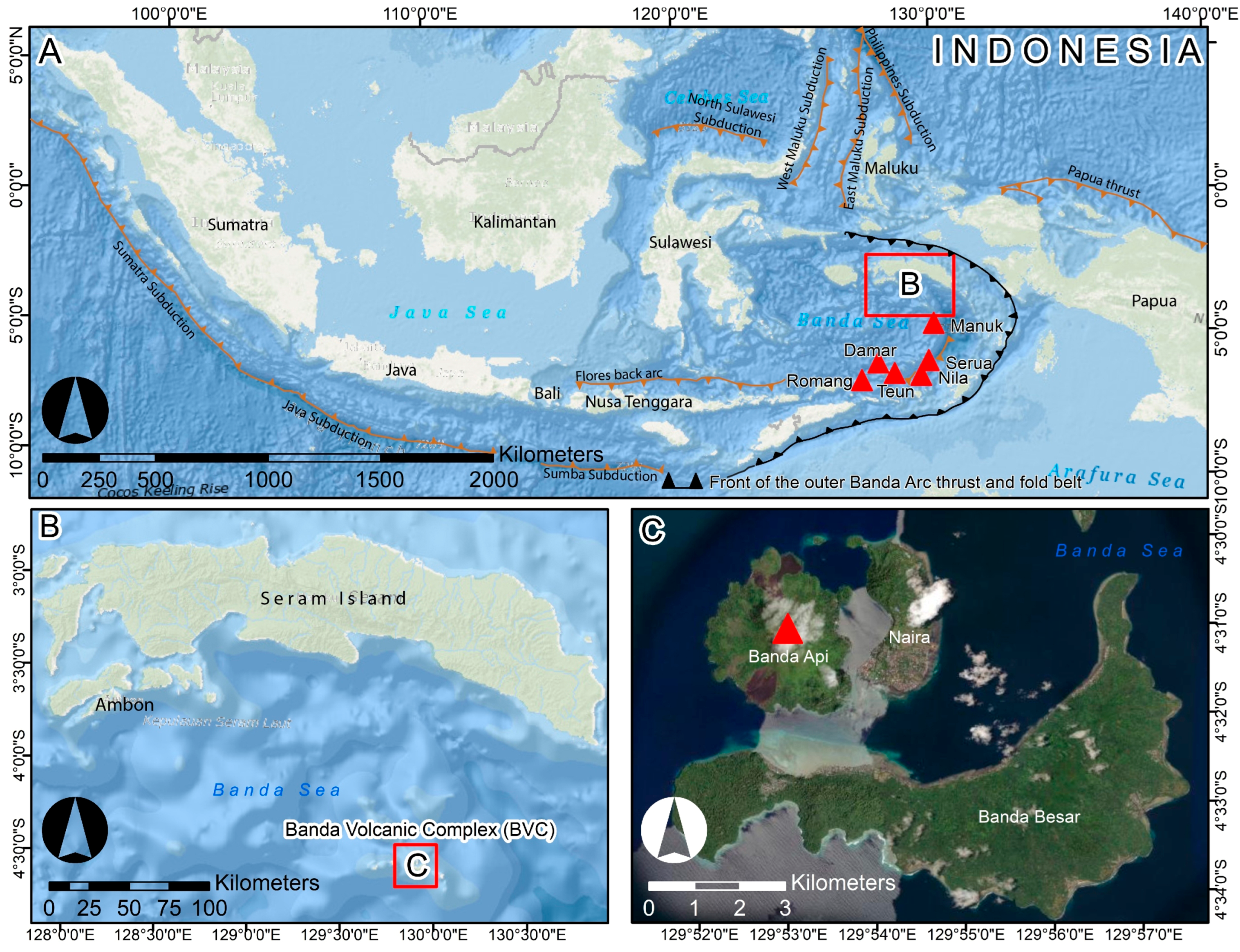




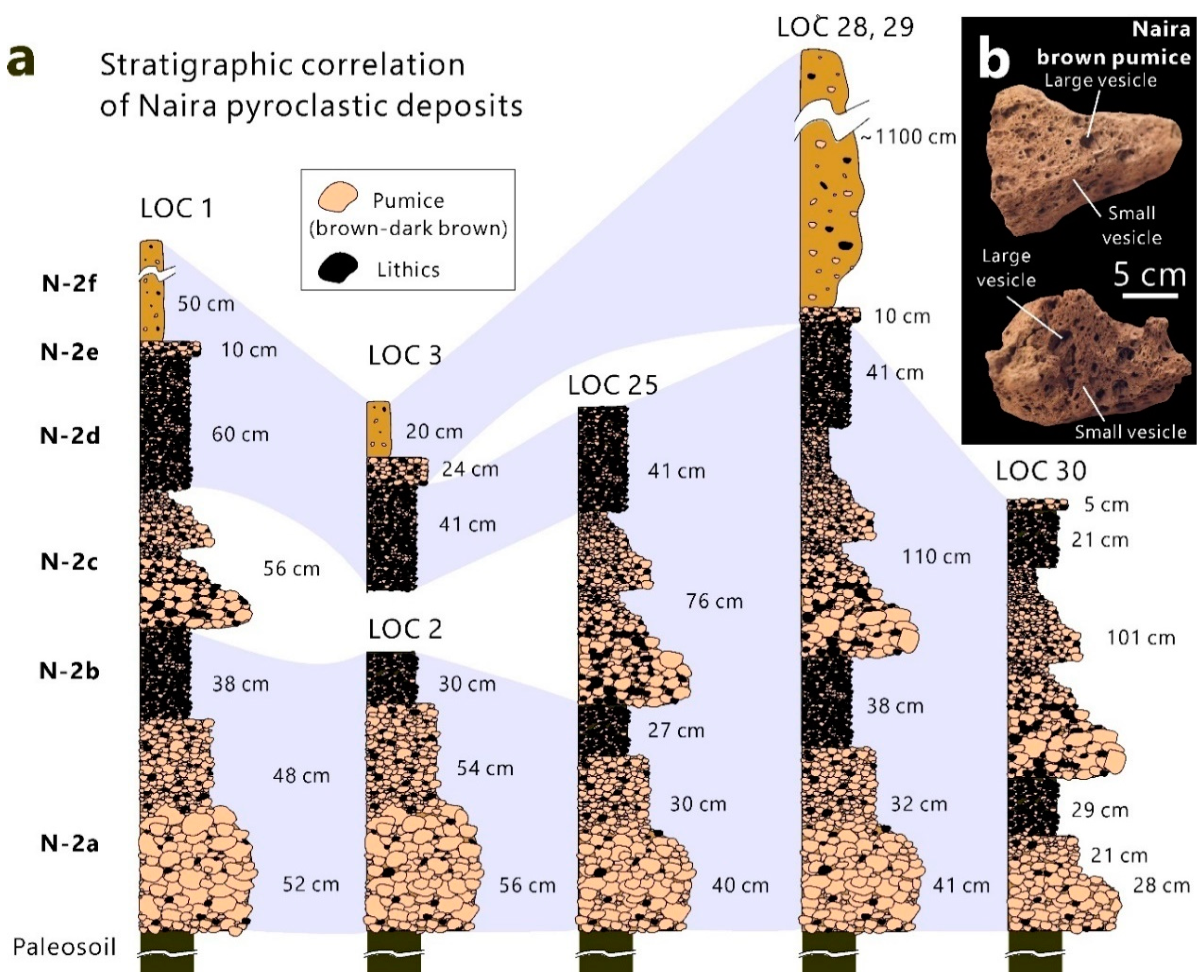



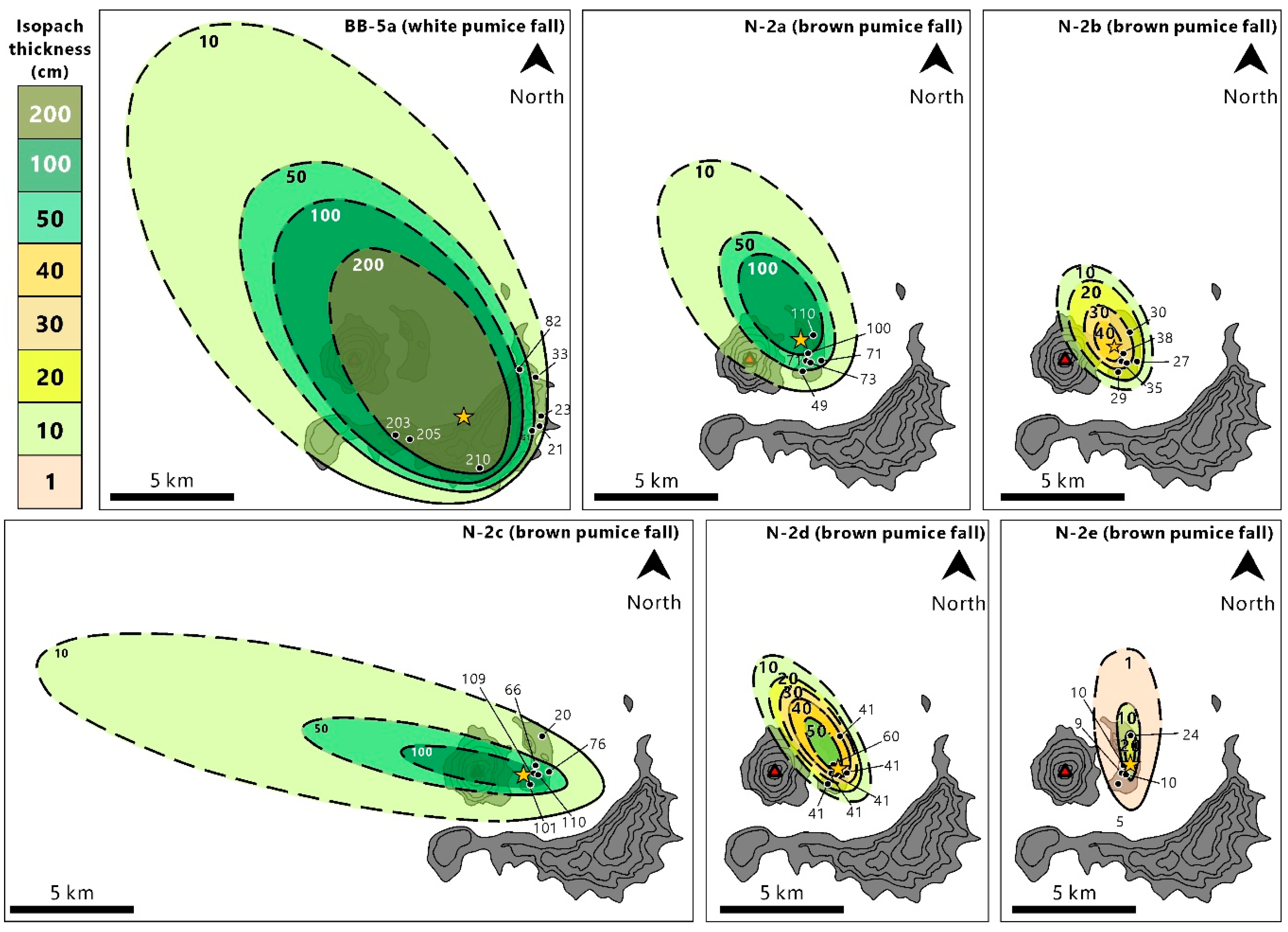
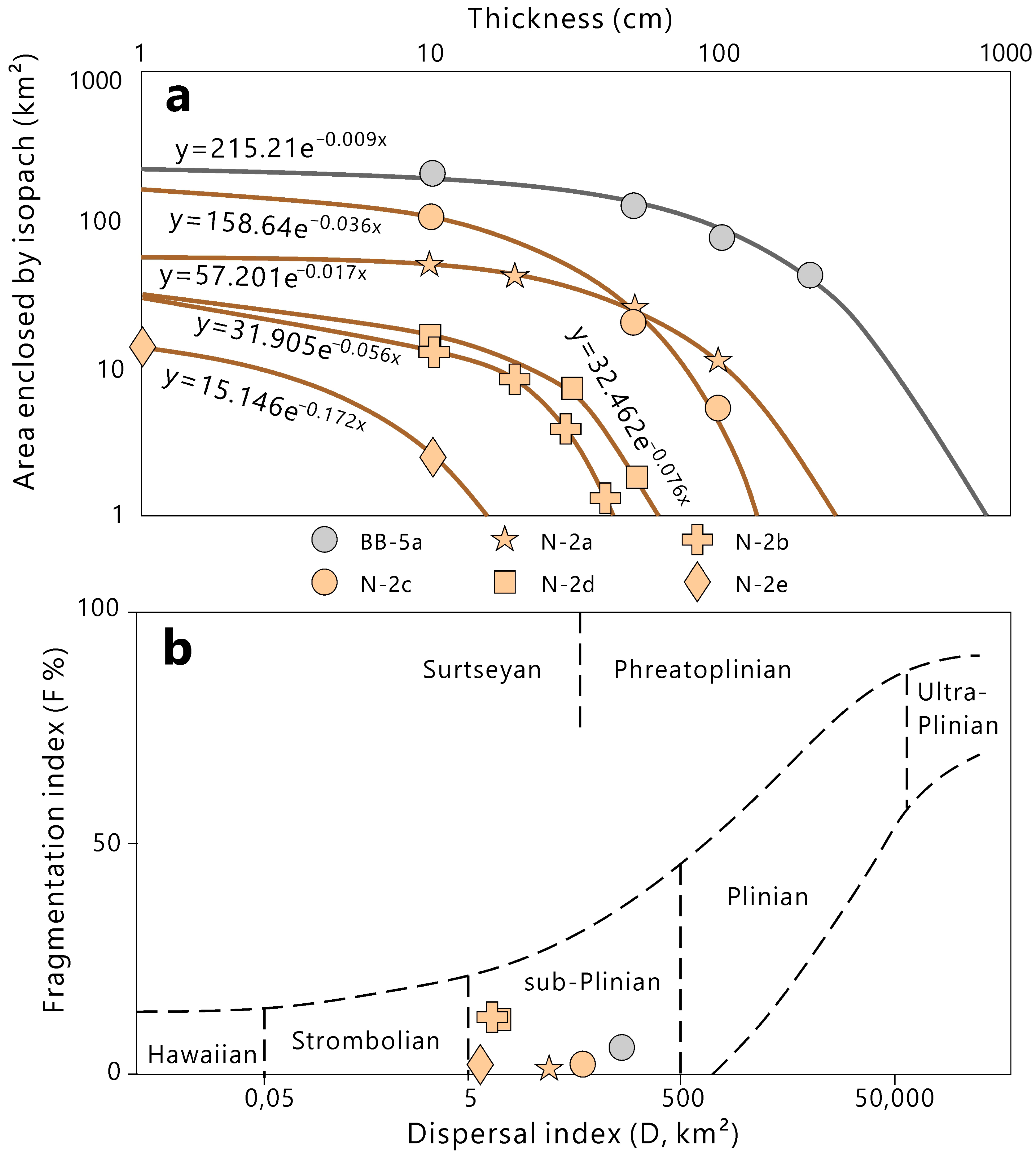
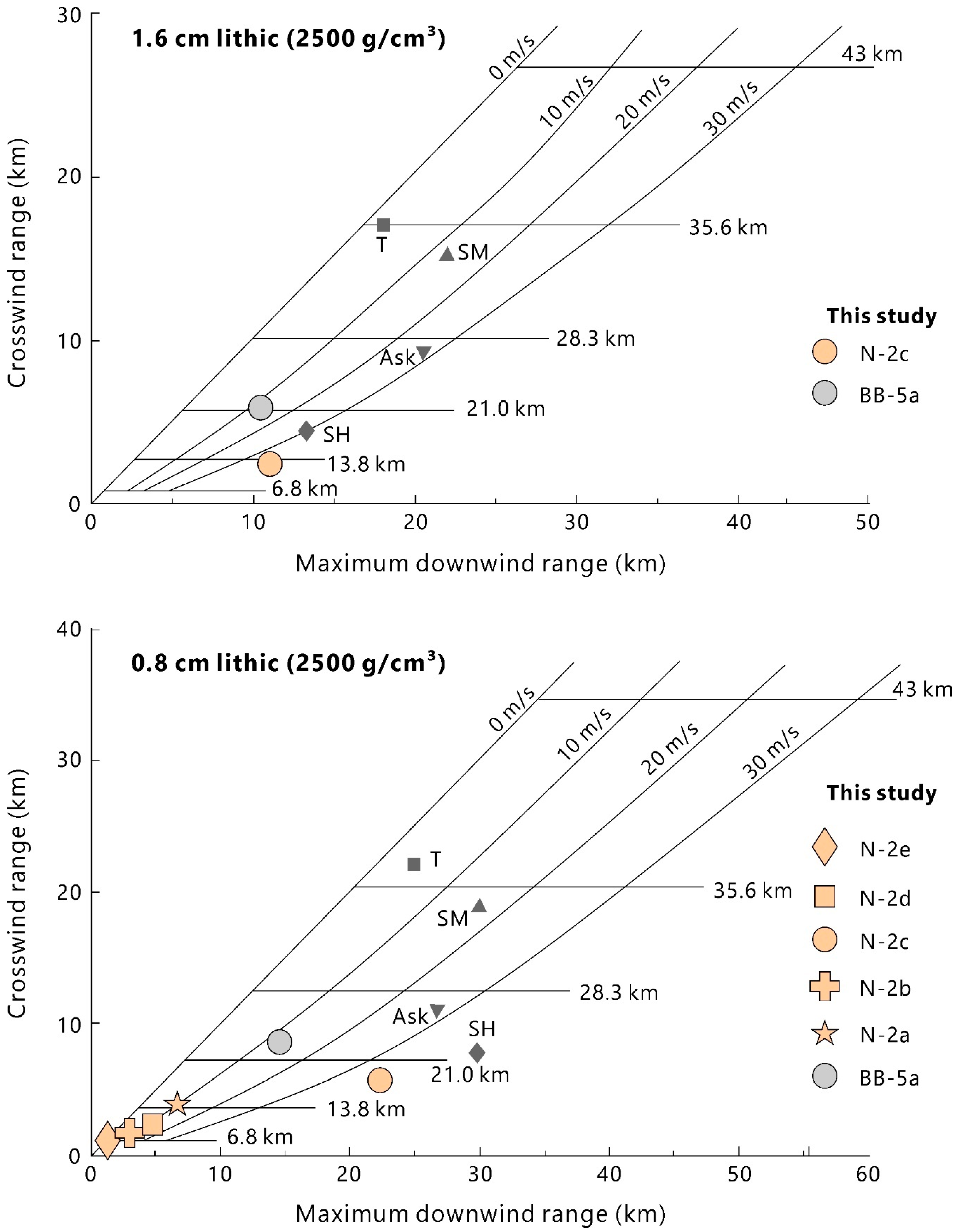
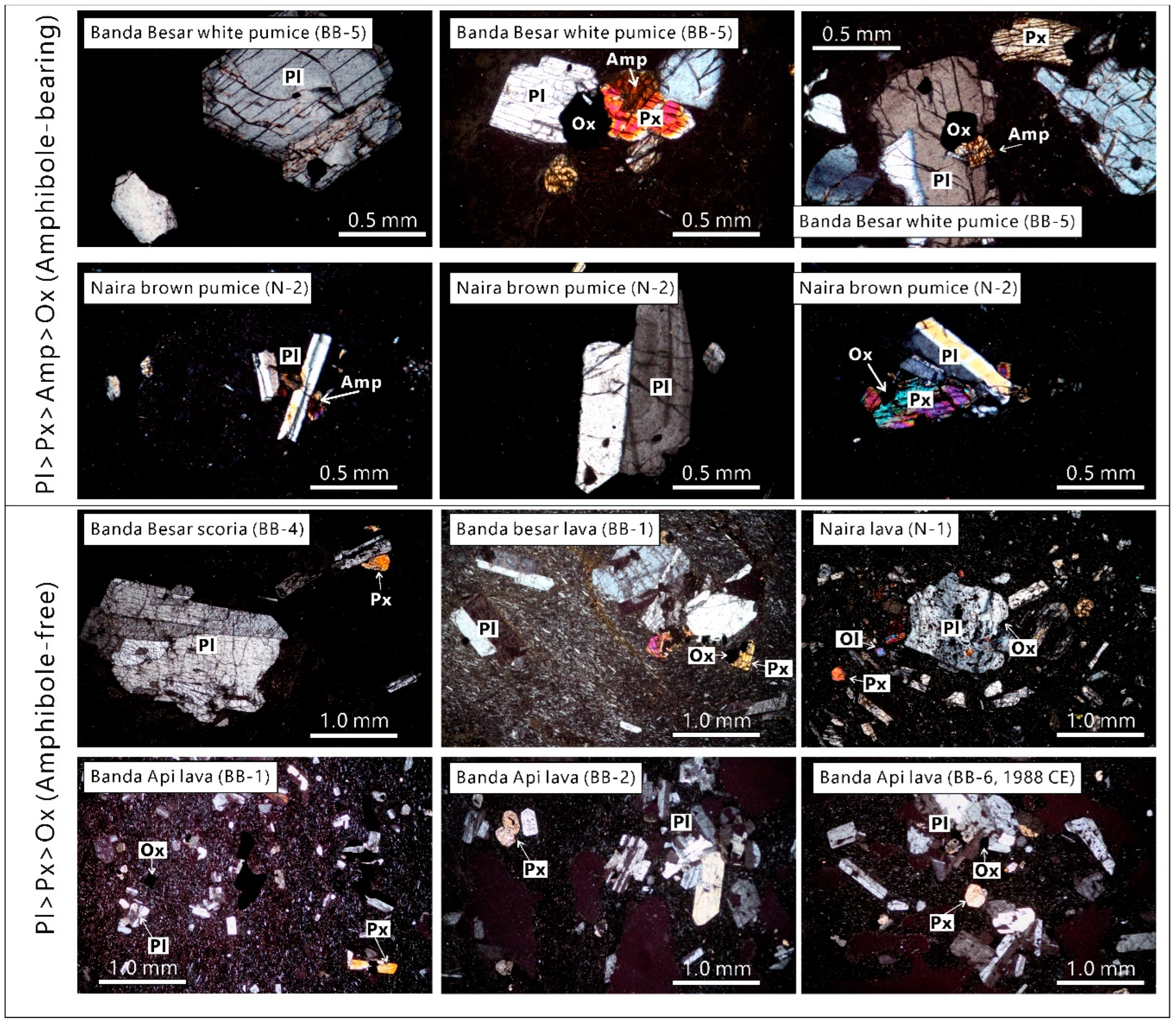
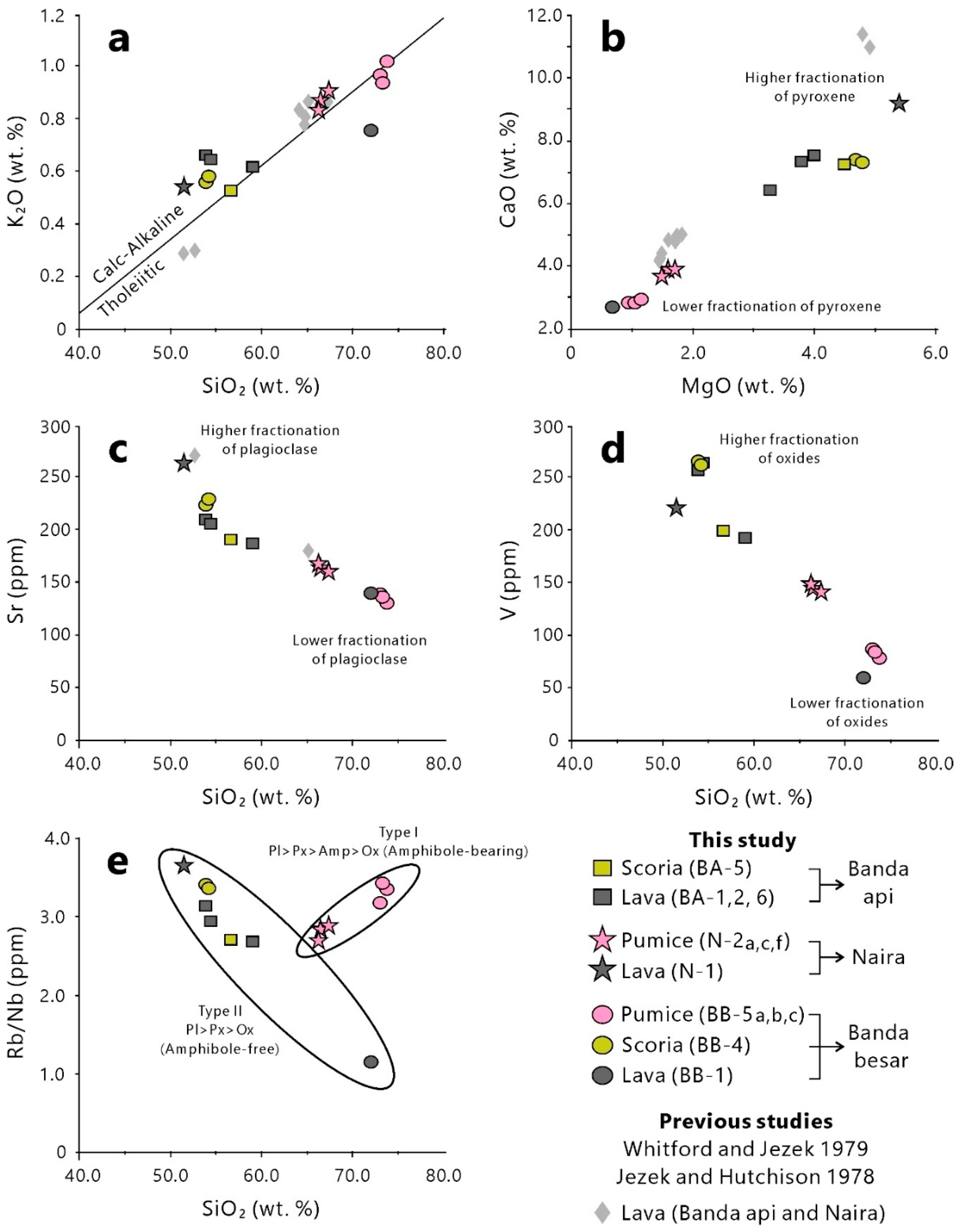
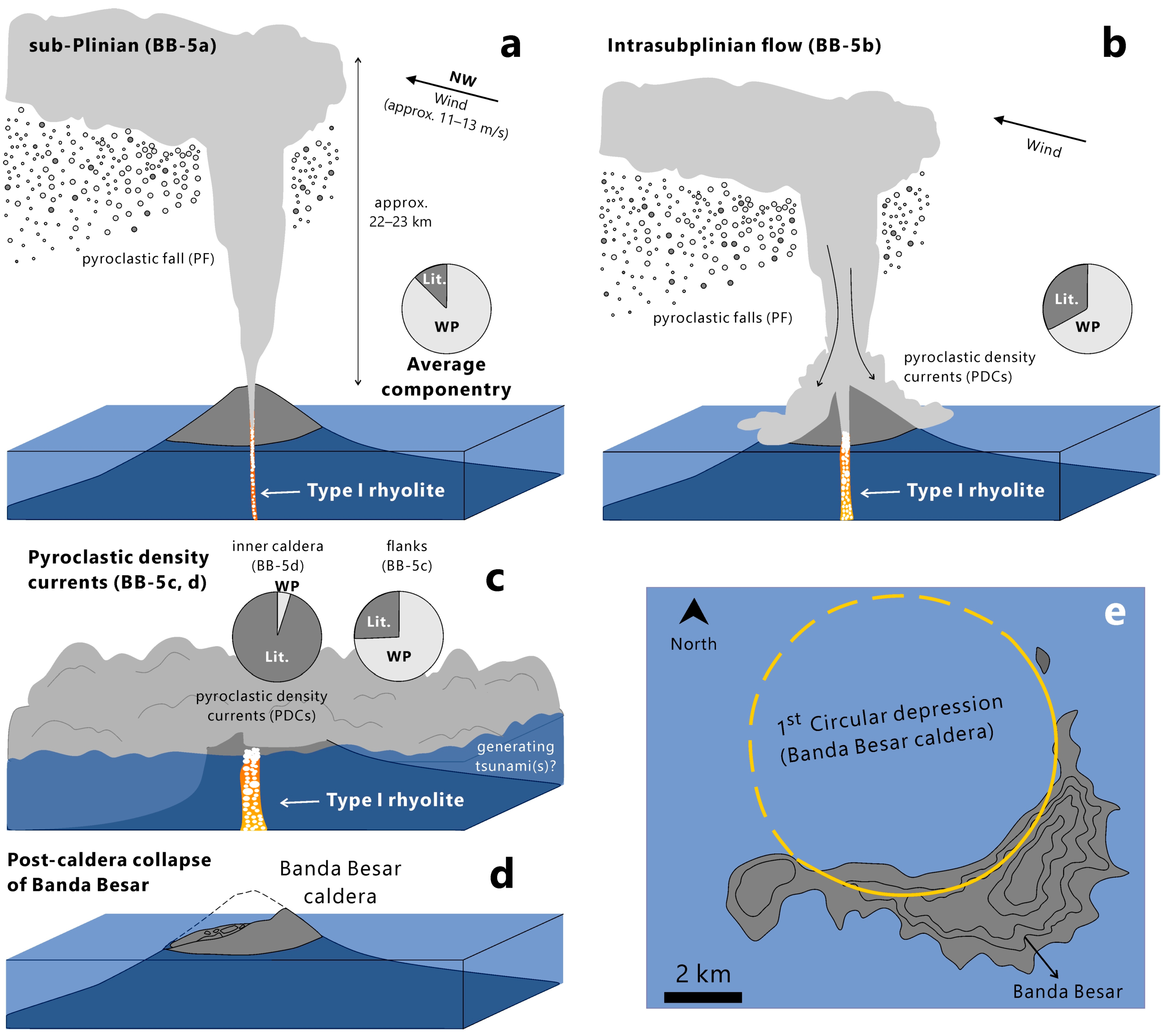
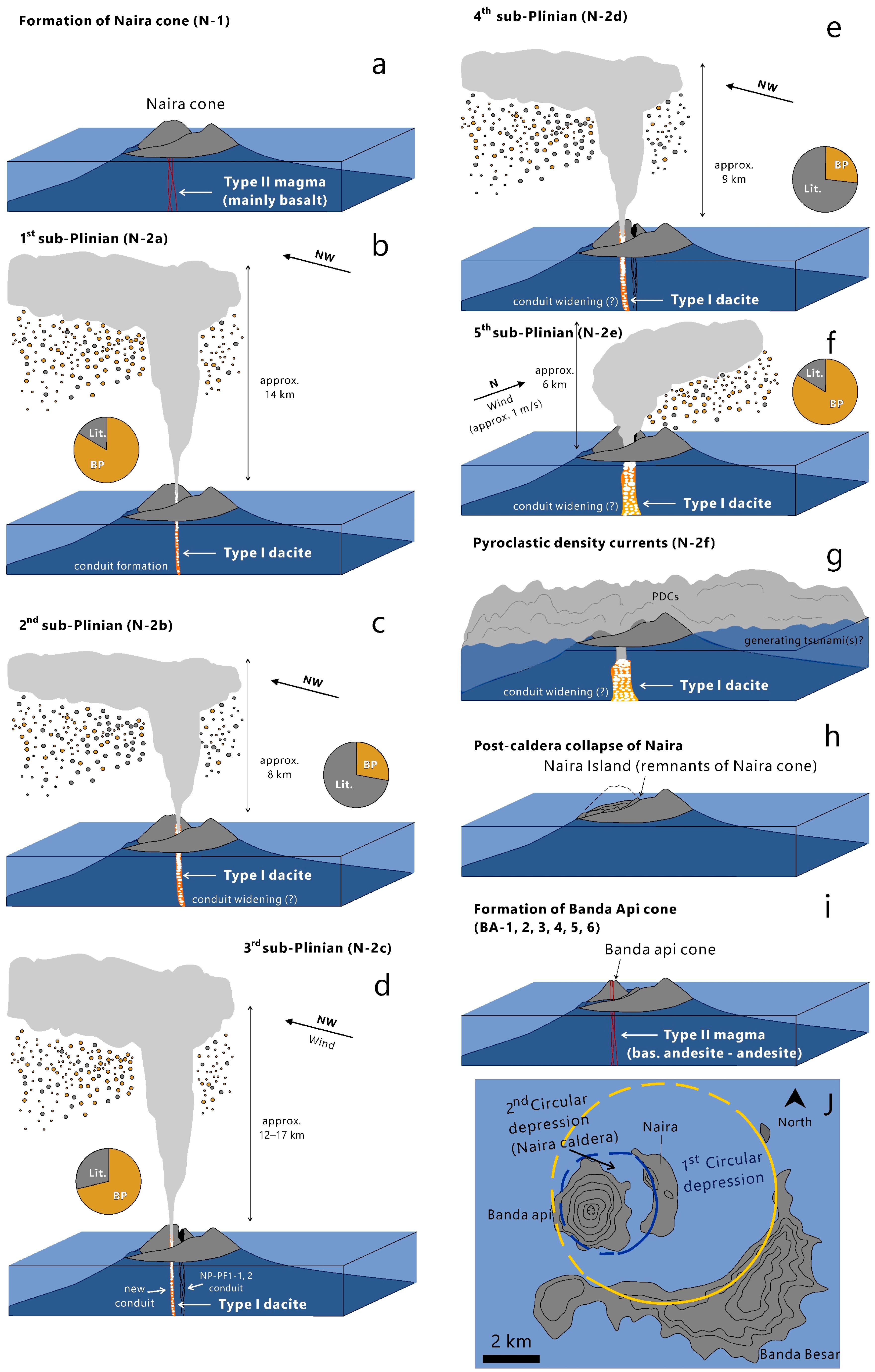
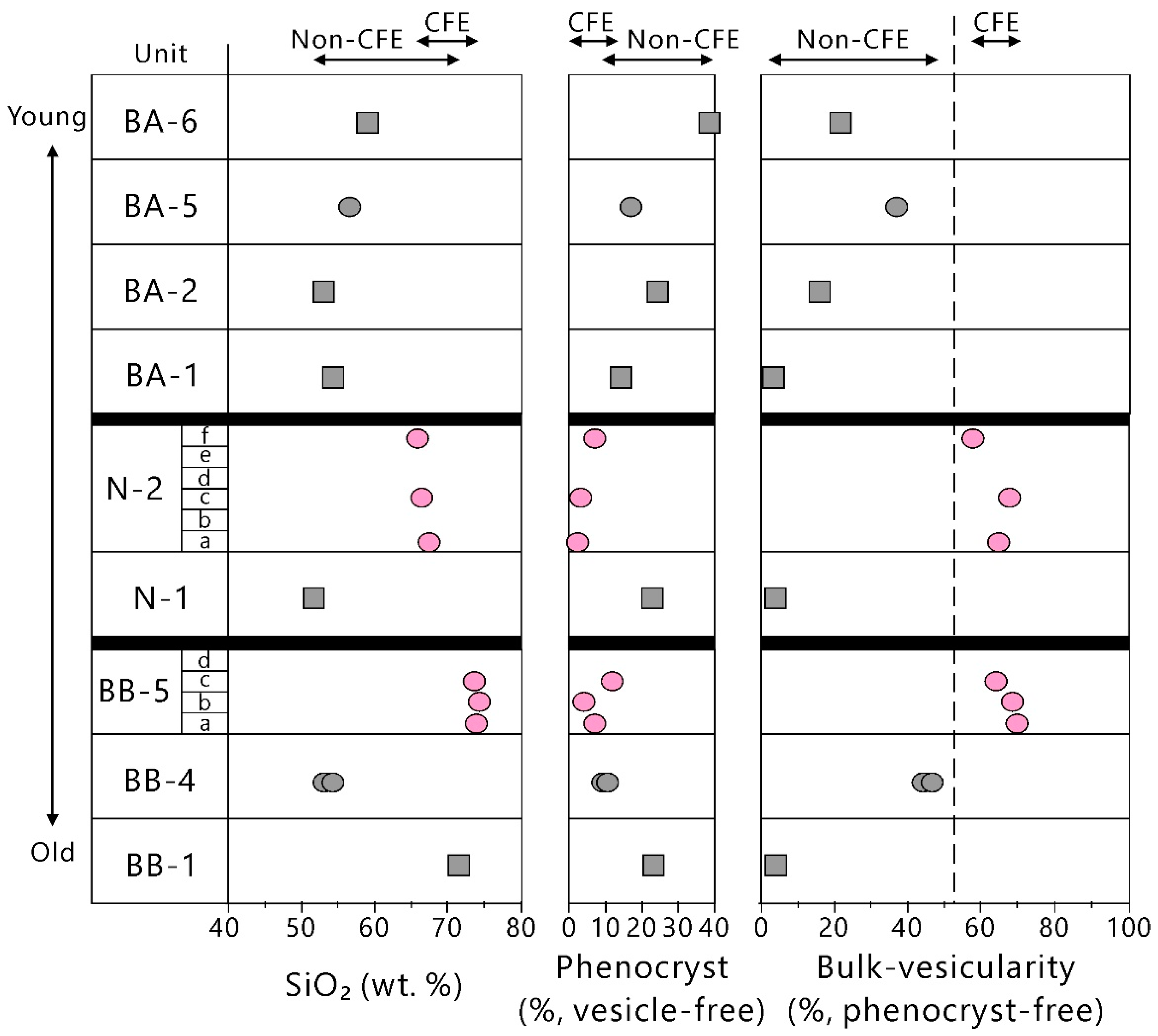
| Name | Thickness (cm) | Minimum Volume (km3) | Lithic Size Class (mm) | Downwind (km) | Crosswind (km) | Column Height (km) | Windspeed (km/h) |
|---|---|---|---|---|---|---|---|
| BB-5a | 210 | 0.91 | 1.60 | 13.14 | 7.43 | 23 | 11 |
| 0.80 | 15.35 | 8.63 | 22 | 13 | |||
| N-2a | 73 | 0.09 | 0.80 | 6.36 | 3.64 | 14 | 11 |
| N-2b | 35 | 0.02 | 0.80 | 2.81 | 1.71 | 9 | 9 |
| N-2c | 110 | 0.10 | 1.60 | 11.20 | 2.21 | 17 | 35 |
| 0.80 | 23.08 | 5.67 | 12 | 35 | |||
| N-2d | 40 | 0.02 | 0.80 | 4.61 | 1.91 | 8 | 10 |
| N-2e | 10 | 0.002 | 0.80 | 3.14 | 0.94 | 6 | 1 |
| Name | d1 (km) | d2 (km) | h (km) | Vmagma (km3) | Avg. Lithic Fraction | Vvanished (km3) | Vtotal (km3) |
|---|---|---|---|---|---|---|---|
| Banda Besar | 8 | 7 | 0.5 | 28.0 | 0.26 | 7.2 | 35.2 |
| Naira | 3 | 3 | 0.2 | 1.8 | 0.35 | 0.6 | 2.4 |
| Element | BB-5a (White Pumice) | BB-5b (White Pumice) | BB-5c (White Pumice) | N-2a (Brown Pumice) | N-2c (Brown Pumice) | N-2f (Brown Pumice) |
|---|---|---|---|---|---|---|
| SiO2 (wt.%) | 73.22 | 73.76 | 73.11 | 67.23 | 66.38 | 66.20 |
| TiO2 (wt.%) | 0.61 | 0.58 | 0.62 | 0.95 | 0.99 | 0.99 |
| Al2O3 (wt.%) | 13.61 | 13.38 | 13.48 | 14.03 | 13.98 | 13.96 |
| MnO (wt.%) | 0.14 | 0.13 | 0.14 | 0.20 | 0.20 | 0.20 |
| MgO (wt.%) | 1.13 | 1.13 | 1.09 | 1.48 | 1.59 | 1.69 |
| CaO (wt.%) | 2.85 | 2.85 | 2.83 | 3.64 | 3.83 | 3.86 |
| Na2O (wt.%) | 3.56 | 3.56 | 3.82 | 4.59 | 4.71 | 4.82 |
| K2O (wt.%) | 0.93 | 0.93 | 0.94 | 0.90 | 0.85 | 0.83 |
| P2O5 (wt.%) | 0.11 | 0.11 | 0.11 | 0.21 | 0.24 | 0.24 |
| Fe2O3 (wt.%) | 4.34 | 4.34 | 4.36 | 6.76 | 6.91 | 6.93 |
| Total (wt.%) | 100.00 | 100.00 | 100.00 | 100.00 | 100.00 | 100.00 |
| Ba (ppm) | 180.00 | 211.10 | 172.50 | 243.60 | 234.80 | 230.30 |
| Ce (ppm) | 39.90 | 37.70 | 39.30 | 49.10 | 49.20 | 50.00 |
| Co (ppm) | 796.76 | 715.62 | 798.75 | 1215.61 | 1260.67 | 1268.05 |
| Cr (ppm) | n.d. | n.d. | n.d. | n.d. | n.d. | n.d. |
| Cu (ppm) | 6.40 | 4.80 | 5.70 | 11.70 | 12.10 | 11.80 |
| Dy (ppm) | 3.30 | 3.30 | 3.30 | 3.33 | 3.33 | 3.33 |
| Ga (ppm) | 15.10 | 14.80 | 14.80 | 17.40 | 17.50 | 17.30 |
| Hf (ppm) | 0.799 | 0.47 | 0.27 | 3.00 | 3.83 | 3.17 |
| Mo (ppm) | n.d. | n.d. | n.d. | n.d. | n.d. | n.d. |
| Nb (ppm) | 7.16 | 7.36 | 7.53 | 8.45 | 8.06 | 7.95 |
| Nd (ppm) | 17.74 | 17.72 | 17.73 | 17.89 | 17.89 | 17.90 |
| Ni (ppm) | n.d. | n.d. | n.d. | 1.41 | 1.20 | 1.67 |
| Pb (ppm) | 9.30 | 9.12 | 8.38 | 11.52 | 12.00 | 11.24 |
| Pr (ppm) | 4.40 | 4.37 | 4.40 | 4.64 | 4.64 | 4.67 |
| Rb (ppm) | 24.59 | 24.91 | 23.89 | 24.59 | 22.36 | 21.35 |
| Sc (ppm) | 14.23 | 12.71 | 13.05 | 19.23 | 19.99 | 21.13 |
| Sr (ppm) | 134.50 | 131.50 | 133.90 | 158.60 | 163.90 | 164.30 |
| Th (ppm) | n.d. | n.d. | n.d. | n.d. | 0.10 | n.d. |
| U (ppm) | n.d. | n.d. | n.d. | n.d. | n.d. | n.d. |
| V (ppm) | 83.10 | 77.10 | 86.00 | 140.80 | 146.90 | 149.30 |
| Y (ppm) | 36.10 | 36.70 | 36.10 | 40.20 | 40.20 | 38.70 |
| Yb (ppm) | 2.63 | 2.62 | 2.62 | 2.69 | 2.69 | 2.68 |
| Zn (ppm) | 68.90 | 68.90 | 68.80 | 105.50 | 105.50 | 106.00 |
| Zr (ppm) | 137.20 | 137.40 | 137.30 | 141.20 | 141.20 | 135.10 |
| Element | BB-1 (Lava) | BB-4 (Scoria) | BB-4 (Scoria) | N-1 (Lava) | BA-1 (Lava) | BA-2 (Lava) | BA-5 (Scoria) | BA-6 (Lava) |
|---|---|---|---|---|---|---|---|---|
| SiO2 (wt.%) | 71.99 | 54.24 | 53.96 | 51.57 | 54.35 | 53.79 | 56.59 | 59.09 |
| TiO2 (wt.%) | 0.48 | 1.38 | 1.40 | 1.11 | 1.31 | 1.28 | 1.09 | 1.09 |
| Al2O3 (wt.%) | 13.33 | 15.51 | 15.46 | 17.60 | 16.22 | 16.12 | 16.60 | 15.69 |
| MnO (wt.%) | 0.08 | 0.25 | 0.26 | 0.20 | 0.22 | 0.22 | 0.21 | 0.20 |
| MgO (wt.%) | 0.67 | 4.80 | 4.69 | 5.41 | 3.99 | 3.80 | 4.49 | 3.27 |
| CaO (wt.%) | 2.65 | 7.23 | 7.31 | 9.12 | 7.46 | 7.29 | 7.14 | 6.33 |
| Na2O (wt.%) | 5.20 | 3.41 | 3.45 | 3.47 | 4.01 | 3.95 | 3.25 | 4.32 |
| K2O (wt.%) | 0.75 | 0.57 | 0.55 | 0.53 | 0.6 | 0.65 | 0.52 | 0.61 |
| P2O5 (wt.%) | 0.12 | 0.15 | 0.15 | 0.15 | 0.17 | 1.61 | 0.14 | 0.14 |
| Fe2O3 (wt.%) | 4.71 | 12.45 | 12.76 | 10.84 | 11.62 | 11.45 | 9.98 | 9.25 |
| Total (wt.%) | 100.00 | 100.00 | 100.00 | 100.00 | 100.00 | 100.00 | 100.00 | 100.00 |
| Ba (ppm) | 171.60 | 288.10 | 292.60 | 229.90 | 263.80 | 262.20 | 213.20 | 217.50 |
| Ce (ppm) | 41.10 | 69.20 | 71.10 | 65.20 | 65.70 | 64.90 | 59.80 | 57.20 |
| Co (ppm) | 876.81 | 2181.61 | 2201.01 | 1863.56 | 2046.09 | 2041.35 | 1740.72 | 166.19 |
| Cr (ppm) | n.d. | 18.44 | 19.45 | 40.24 | 31.92 | 31.46 | 4.86 | 1.26 |
| Cu (ppm) | 8.30 | 42.90 | 43.80 | 54.00 | 41.70 | 36.20 | 37.90 | 28.20 |
| Dy (ppm) | 3.31 | 3.39 | 3.39 | 3.37 | 3.38 | 3.38 | 3.36 | 3.35 |
| Ga (ppm) | 15.50 | 22.70 | 22.50 | 20.00 | 21.20 | 21.30 | 20.20 | 18.90 |
| Hf (ppm) | n.d. | 10.82 | 10.30 | 8.46 | 9.14 | 8.73 | 6.92 | 5.62 |
| Mo (ppm) | n.d. | n.d. | n.d. | n.d. | n.d. | n.d. | n.d. | n.d. |
| Nb (ppm) | 6.87 | 5.61 | 5.41 | 4.16 | 5.44 | 5.35 | 5.15 | 5.71 |
| Nd (ppm) | 17.79 | 18.19 | 18.22 | 18.12 | 18.15 | 18.14 | 18.04 | 18.00 |
| Ni (ppm) | n.d. | 11.95 | 24.23 | 18.11 | 14.23 | 13.91 | 18.86 | 11.85 |
| Pb (ppm) | 3.05 | 15.54 | 15.47 | 10.99 | 12.54 | 12.33 | 12.32 | 10.56 |
| Pr (ppm) | 4.47 | 5.12 | 5.17 | 5.01 | 5.05 | 5.03 | 4.88 | 4.83 |
| Rb (ppm) | 7.80 | 18.81 | 18.73 | 15.18 | 15.93 | 16.78 | 13.93 | 15.28 |
| Sc (ppm) | 14.91 | 37.50 | 39.02 | 35.54 | 35.66 | 34.07 | 31.45 | 28.19 |
| Sr (ppm) | 140.80 | 205.30 | 207.30 | 263.40 | 227.60 | 226.60 | 189.50 | 187.90 |
| Th (ppm) | n.d. | 11.52 | 12.57 | 6.75 | 7.98 | 7.03 | 5.80 | 1.21 |
| U (ppm) | n.d. | 4.71 | 4.59 | 2.83 | 3.00 | 2.87 | 2.49 | 0.62 |
| V (ppm) | 59.80 | 263.20 | 265.30 | 222.20 | 264.20 | 263.20 | 198.60 | 195.50 |
| Y (ppm) | 34.70 | 30.30 | 30.50 | 23.60 | 26.90 | 25.60 | 27.80 | 29.10 |
| Yb (ppm) | 2.59 | 2.90 | 3.13 | 3.02 | 2.94 | 2.93 | 3.05 | 2.88 |
| Zn (ppm) | 76.70 | 126.30 | 125.10 | 88.80 | 100.80 | 99.50 | 97.30 | 100.70 |
| Zr (ppm) | 121.50 | 89.90 | 90.70 | 76.40 | 89.30 | 88.90 | 84.10 | 93.20 |
Publisher’s Note: MDPI stays neutral with regard to jurisdictional claims in published maps and institutional affiliations. |
© 2022 by the authors. Licensee MDPI, Basel, Switzerland. This article is an open access article distributed under the terms and conditions of the Creative Commons Attribution (CC BY) license (https://creativecommons.org/licenses/by/4.0/).
Share and Cite
Suhendro, I.; Mutaqin, B.W.; Sobaruddin, D.P.; Agustiningtyas, L.; Humaida, H.; Marfai, M.A.; Hadmoko, D.S. Dynamics of Two Caldera-Forming Eruptions (Banda Besar and Naira) in the Marine Conservation Zone of Banda, Maluku, Indonesia. Geosciences 2022, 12, 428. https://doi.org/10.3390/geosciences12110428
Suhendro I, Mutaqin BW, Sobaruddin DP, Agustiningtyas L, Humaida H, Marfai MA, Hadmoko DS. Dynamics of Two Caldera-Forming Eruptions (Banda Besar and Naira) in the Marine Conservation Zone of Banda, Maluku, Indonesia. Geosciences. 2022; 12(11):428. https://doi.org/10.3390/geosciences12110428
Chicago/Turabian StyleSuhendro, Indranova, Bachtiar W. Mutaqin, Dyan Primana Sobaruddin, Lestari Agustiningtyas, Hanik Humaida, Muh Aris Marfai, and Danang Sri Hadmoko. 2022. "Dynamics of Two Caldera-Forming Eruptions (Banda Besar and Naira) in the Marine Conservation Zone of Banda, Maluku, Indonesia" Geosciences 12, no. 11: 428. https://doi.org/10.3390/geosciences12110428
APA StyleSuhendro, I., Mutaqin, B. W., Sobaruddin, D. P., Agustiningtyas, L., Humaida, H., Marfai, M. A., & Hadmoko, D. S. (2022). Dynamics of Two Caldera-Forming Eruptions (Banda Besar and Naira) in the Marine Conservation Zone of Banda, Maluku, Indonesia. Geosciences, 12(11), 428. https://doi.org/10.3390/geosciences12110428








